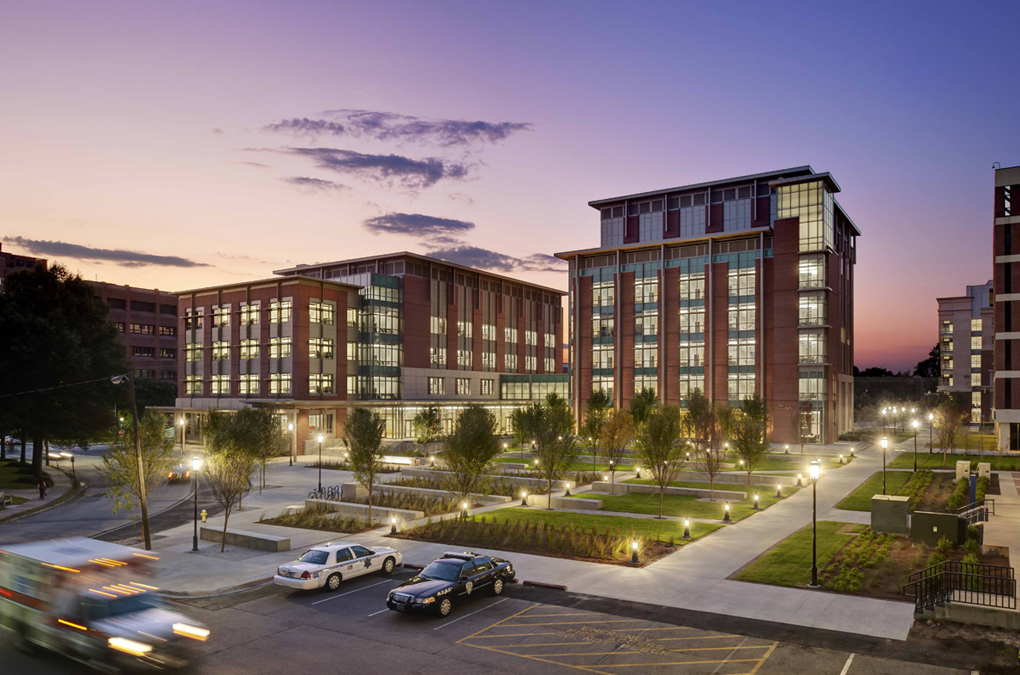Goody Clancy and Stevens & Wilkinson announced that two new research buildings on the campus of the Medical University of South Carolina in Charleston, S.C. were formally dedicated late in 2011.
The two buildings add 208,000 square feet of collaborative research space to the campus. The James E. Clyburn Research Center comprises two buildings, the Drug Discovery Building and the Bioengineering Building. The research center brings together scientists, faculty and students from the state’s three research universities: MUSC, the University of South Carolina and Clemson University, as well as representatives from private industry, to advance biomedical research and applications and speed up the process of technology transfer.
The project team includes: Goody Clancy, Boston, MA (Design Architect), led by principal Roger Goldstein, FAIA, LEED AP; Stevens & Wilkinson SC, Columbia, SC (Architect of Record, Mechanical/Electrical, Civil and Structural Engineer), led by principal Robby Aull, AIA, ACHA, LEED AP; Brasfield & Gorrie, LLC, Birmingham, AL (General Contractor); Seamon Whiteside + Associates, Mount Pleasant, SC (Landscape Architect); SST Planners, Arlington, VA (Lab Planners); and Vermeulens Cost Consultants, Boston, MA (Cost Consultant). Vanderweil, Boston, MA also served as the Mechanical Design Engineer for the Drug Discovery Building. BD+C
Related Stories
Sports and Recreational Facilities | Jul 17, 2015
Japan scraps Zaha Hadid's Tokyo Olympic Stadium project
The rising price tag was one of the downfalls of the 70-meter-tall, 290,000-sm stadium. In 2014, the cost of the project was 163 billion yen, but that rose to 252 billion yen this year.
Cultural Facilities | Jul 16, 2015
Louisville group plans to build world's largest disco ball
The sphere would more than double the size of the current record holder.
Education Facilities | Jul 14, 2015
Chile selects architects for Subantarctic research center
Promoting ecological tourism is one of this facility’s goals
BIM and Information Technology | Jul 14, 2015
New city-modeling software quantifies the movement of urban dwellers
UNA for Rhino 3D helps determine the impact that urban design can have on where pedestrians go.
Industrial Facilities | Jul 14, 2015
Tesla may seek to double size of Gigafactory in Nevada
Tesla Motors purchased an additional 1,200 acres next to the Gigafactory and is looking to buy an additional 350 acres.
BIM and Information Technology | Jul 14, 2015
Nation’s first 'drone park' breaks ground in North Dakota
This is one of six testing sites around the country that are developing flight standards and evaluating the utility of drones for different tasks.
Sponsored | Building Team | Jul 10, 2015
Are you the wrong type of ‘engaged’ leader?
Much of what’s written about employee engagement focuses on how leaders can help their employees become more involved at work. But what about the leaders themselves?
Architects | Jul 9, 2015
NCARB: Record number of aspiring architects on path toward licensure
More than 37,170 design professionals either reported hours through the Intern Development Program or tested for the Architect Registration Examination last year, according to a new NCARB report.
Architects | Jul 7, 2015
Why AEC firms should be cultivating 'visible experts'
A new study pinpoints the true dollar value of having knowledge leaders and market shapers on your team.
Green | Jul 7, 2015
Philips sheds new light on growing fresh food indoors
A research center in The Netherlands is testing the latest techniques in urban farming.
















